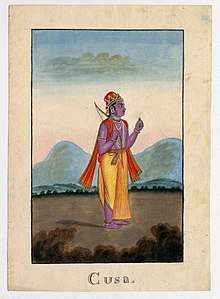Kusha (Ramayana)
Kush or Kusa (Sanskrit: कुश) and his twin brother Lava were the children of Rama and Sita. Their story is recounted in the Hindu epic, Ramayana and its other versions. Hindu traditions claim he ruled the entire region of Kashmir, Indus River and Hindu Kush as frontier lands of India known as Hindu Kush Kshetra and founded the city of Kashmir in the valley and Kasur with Lavapuri of lava in base lands,[1] though local lore contends Kasur was founded in 1525 by Pashtun migrants.[2][3][4] His brother Lava is traditionally believed to have founded Lavapuri (present-day city of Lahore).
| Kusha | |
|---|---|
 | |
| Texts | Ramayana and its other versions |
| Personal information | |
| Born | |
| Parents | |
| Siblings | Lava |
| Consort | Kumudvatī |
| Children | (Married to Yadava King Mahabhoja) |
| Dynasty | Raghuvanshi-Ikshvaku-Suryavanshi |

Kusha is said to be a Raghuvanshi Ikshvaku Suryavanshi.
Birth and childhood


According to the Ramayana, a pregnant queen Sita leaves the kingdom of Ayodhya when she comes to know that Ram was anxious when he heard a washerman of Ayodhya questioning Sita's purity . She then took refuge in the ashram of the sage Valmiki located on the banks of the Tamsa River.[5] Sita gave birth to twin sons, Lava and Kusha, at the ashram and were educated and trained in military skills under the tutelage of Sage Valmiki. They also learned the story of Rama.
Ashwamedha Yagya
During an Ashvamedha Yagya held by Rama, Sage Valmiki along with Lava and Kusha, attended with Sita in disguise.
Lava and Kusha chanted the Ramayana in the presence of Rama and a vast audience. When Lava and Kusha recited about Sita's exile, Rama became grief-stricken and Valmiki produced Sita. Sita, struck with embarrassment and grief, called upon the earth, her mother (Bhūmi), to receive her and as the ground opened, she vanished into it. Rama then learnt that Lava and Kusha were his children.
In some versions, Lava and Kusha capture the horse of the sacrifice and defeat Rama's brothers and their army and when Rama came to fight with them, Maharishi Valmiki intervened and then Sita discloses to their sons that there father is Lord Rama and Valmiki told the children that through song they have to recite the story of holy Ramayana to the people of Ayodhya that how Sita sacrifices even Gold Lanka(Ravana Mahal) to wash away the spoilt image of Sita from Ayodhya people.
Later history
Lava and Kusha became rulers after their father Rama founded the cities of Lavapuri (currently identified as modern day "Lahore") and Kasur respectively.
Cantos sixteen to nineteen of the Ānanda Rāmāyaṇa describes the exploits of Rama's progeny. The manifestation of a Goddess appears before Kusha, declaring to be the Tutelary deity of the ancient capital of Ayodhya. She described the condition of the deserted city, which had been abandoned and ruined since the departure of King Ram. Kusha sets forth with his whole army to restore the city to its former splendor.
Cantos sixteen describes Kushas marriage with the Naga Queen Kumudvatī. While residing in Ayodhya in the summer, Kusha goes to the Sarayu to bathe with the ladies of the court. While sporting in the river, he loses a great gem bestowed to him by his father. In anger Kusha threatens to shoot an arrow into the river, whereupon the river parted revealing Kumudvatī.
Cantos seventeen describes the final years of Kusha. Kusha and Kumudvati have a son name Atithi, who becomes heir to the kingdom. Kusha engages in a battle with a demon and gives his life in the process of slaying his adversary. Cantos eighteen and nineteen describe the 21 Kings that succeeded Atithi.
Kushavati was a city in Kosala Kingdom as related in the epic Ramayana. The king of Kosala, Rama, installed his son Lava at Sravasti and Kusha at Kushavati.
References
- Nadiem, Ihsan N. "Kasur ancient name". Punjab, Pg.111. Google Books.
- Chopra, Gulshan Lall (1940). Chiefs and Families of Note in the Punjab. Government Printing.
- Sikand, Yoginder (19 July 2011). Beyond The Border: An Indian in Pakistan. Penguin UK. ISBN 9789352141326.
- Nadiem, Ihsan H. (2005). Punjab: land, history, people. al-Faisal Nashran. ISBN 9789695032831.
- Vishvanath Limaye (1984). Historic Rama of Valmiki. Gyan Ganga Prakashan.
.jpg)